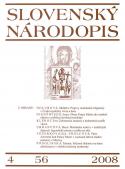Zobrazenia madony a ich hodnotenie podľa osobného vkusu
The Images of Madonna and the Judgment of Taste
Author(s): Ewa KlekotSubject(s): Anthropology
Published by: SAV - Slovenská akadémia vied - Ústav etnológie a sociálnej antropológie Slovenskej akadémie vied
Keywords: judgment of taste; images of Madonna; social classification;
Summary/Abstract: The field of art in modern Western world has elaborated its own strategies and scales of evaluation [Bourdieu: 1993]; the judgment of taste; this in the late modernity has become a sensitive and very efficient mechanism of social classification [Bourdieu: 1989]. Taste classifies but it also classifies the classifier. It means that any aesthetic choices made contain double-edged information: about the object of choice and about its subject, and the latter refers to the social origin and position of the choice-maker. Valorization of so-called Christian religious art (all the images in shrines and churches are supposed to belong to this category) is therefore a process relying on a complicated framework of implicit and explicit value systems, belonging to different social fields (art and religion), and reflecting both the struggles within the fields, as well as the tensions between the fields themselves. The fieldwork most extensively quoted was done in Wesoła near Warsaw, and consisted of open interviews on preferences in religious imagery and art that always used to be inaugurated by a talk over a selection of religious prints and images provided by the interviewer. The selection contained the most popular images of the Virgin (Black Madonna from Częstochowa), some reproductions of well-known Western artworks representing Madonna (e.g. the Sistine Madonna), a reproduction of an Orthodox icon, an image originating in some non-European Christian context and some stamps in both sweet Roma Marianum esthetics as well as more graphic, linear and symbolic in style. The objective was to make the interview less abstract, and the selection of images had been made as to show the perception of such qualities as execution style, and its evaluation. The analysis of the research material clearly shows that the preference is given to the images the can easily evoke the prototype. It is all the time present that the image of Madonna is first of all her image, and should be recognizable as such: it is the skill in “good” representing the protagonist/subject that all the evaluations are considering. Images that are not clearly recognizable make the informants feel uncomfortable, and are not highly appreciated; both the protagonist should be recognizable, as well as her significant attributes. However, familiarity results from a quite complex set of stylistic and iconographic features of an image. Third feature that proved to be important to the informants in selecting the preferred image was the familiar physical type of represented person. The exotic Madonnas were called sometimes “beautiful” but this was immediately followed by “but different,” “strange,” however, the term “not ours” were never used. “Not ours” has been apparently reserved for the less exotic others, while the exotic ones were still so far that were outside of the ours / not ours categorization.
Journal: Slovenský národopis
- Issue Year: 56/2008
- Issue No: 4
- Page Range: 388 - 398
- Page Count: 11
- Language: Slovak

